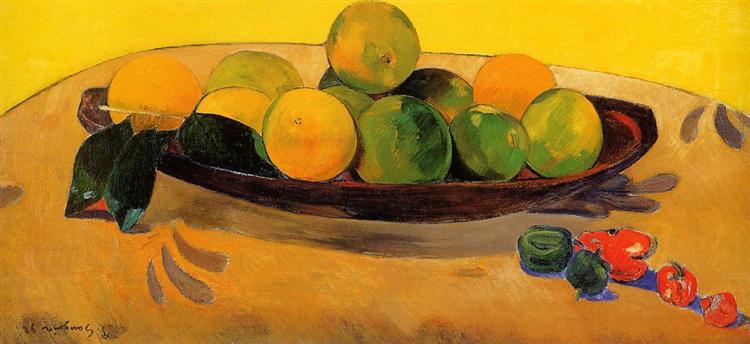Opis
Paul Gauguin's painting "Still Life with Tahitian Oranges" (1892) is a work that embodies the painter's artistic evolution towards a more intense search for harmony between colour and form, as well as his desire to escape European conventions and immerse himself in the rich Polynesian culture. This work is set in a significant period of his career, when he moved to Tahiti in an attempt to connect with the primitive and the authentic, in a context that he considered purer and more vital than the Western world.
The composition of the still life is remarkable for its simplicity, which, far from limiting the work, enhances it. In the foreground, a set of bright oranges rests on a shadowy surface, perhaps a table, capturing the light in hues that border on the almost vibrant. The oranges, mostly a deep yellow with shades of intense orange, are presented in counterpoint to a background that tends toward a dark, neutral blue, achieving an almost painterly effect that reverberates with vibrations of warmth and richness. This use of color, characteristic of Gauguin, is not merely decorative; it is a vehicle for conveying sensations, a visual language that encompasses Gauguin's desire to transcend mere representation.
Although its main subject is a still life, the work is imbued with the artist’s philosophy, who sought in his still lifes a connection beyond the objects he represented. The oranges symbolize not only the aesthetics of the tropics, but also the exploration of one’s own being and a response to his search for pure beauty. In this sense, each fruit can be considered a sensorial link between the viewer and the world that Gauguin wanted to portray, a world free from the artificiality of progress.
It is interesting to note how Gauguin has incorporated his distinctive post-impressionist style into this work. His rejection of realism and the precise search for light and form reflects a deeper attention to the inner qualities of objects, using colours to simulate moods rather than faithfully replicate reality. The forms, often simplified and heightened, take us to a place where contemplation becomes essential, where each orange and each shadow lacks a strictly representative function, proposing instead an aesthetic experience.
Still Life with Tahitian Oranges also enters into dialogue with other contemporary works by Gauguin where fruitiness and color saturation are recurring elements. It is possible to compare it with other works of his that incorporate still lifes or with the impressive variety of landscapes and portraits of Tahitian women that continued to develop in his later output. However, this particular still life is distinguished by its minimalism in composition and by its focus on a single element, suggesting that the depth of Gauguin's exploration did not necessarily require the multiplicity of subjects.
In conclusion, “Still Life with Tahitian Oranges” is more than just a portrait of fruit, it is an artistic statement of Paul Gauguin’s aspirations in his journey towards a more honest and uninhibited art. The work is a reflection of his fascination with the vibrant colors and light of the tropics, as well as his longing to redirect the gaze towards the very essence of nature and life. This piece not only captures visual beauty in a moment in time, but also invites the viewer to contemplate a vast emotional and spiritual horizon, all encompassed in the pulsating vibration of a few simple oranges.
KUADROS ©, a famous painting on your wall.
Hand-made oil painting reproductions, with the quality of professional artists and the distinctive seal of KUADROS ©.
Painting reproduction service with satisfaction guarantee. If you are not completely satisfied with the replica of your painting, we will refund 100% of your money.

